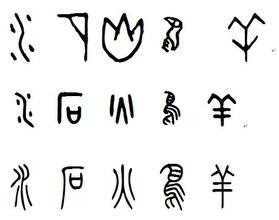From Shang Dynasty to Warring States, more than 1200 years, Ancient Chinese used Shell-Bone script and Bronze script (similar to Shell-Bone script on bronze). As we have seen in previous section that one characters has many variants, like 齒(tooth) and 車(vehicle).
齒 - Tooth variants in Shell-Bone script
車 - Vehicle variants in Shell-Bone script
魚 - Fish variants in Shell-Bone script
Because different people drew characters differently, so there were many different “Tooth”, “Car”, "Fish", and others. In the early time, the characters were used in divination, an event not occurred often, not for ordinary people. Only a few people needed to be able to read and write.
As China evolved from Stone Age to Bronze Age, the increased productivity desired more cooperation and communication between people. More and more people wrote their important data, schedules, letters and records.
It was too slow to carve on the shell or bone, and too expensive and very slow to cast characters on bronze. Some rich people could write on animal skin, and silk, much faster but very expensive. Ordinary people made bamboo or wooden slips for writing, which was cheap and more affordable.
People could make ink and brush at that time. As more and more people wrote, there were more and more variants of each character. Before Qin Dynasty, there were tens states in China, which made variants even more in state level. People had confusion in reading different variants.
After defeating all other countries, the First Emperor Qin Shihuang wanted to unify the scripts, he ordered Mr. Si Li, vice prime minister and calligraphist, to create a new script. Based on Shell-Bone script and Bronze script, Mr. Si Li created Small-Seal, which became the official script of Qin Dynasty. Mr. Li was the first calligraphist in China who has been remembered with his script.
- Taishan Stone - Small Seal script by Mr. Si Li (Qin Dynasty).
- Comparison between Shell-Bone, Bronze, and Small Seal scripts:
From left to right: Water, Stone, Fire, Bird, Sheep;
From top to bottom: Shell-Bone script, Bronze script, Small Seal script
We can see the difference between the three scripts is significant but still very similar. The bottom line of Small-Seal script became more curving and smoother in comparison with the Shell bone, and Big seal scripts (the top two lines). The dots in Shell-Bone or Bronze scripts became short lines in Small Seal script. Basically, the Small-Seal script is more beautiful but less pictograph. The characters were standardized as official language.
However, the Emperor Qin was a tyrannical dictator, people were forced to fight back. Even though Qin built the Great Wall, but couldn’t defend the attack from its own people. Qin Dynasty was overthrowing in less than 15 years (221 - 207 B.C.), became the shortest Dynasty in China history.
So the Small-Seal script didn’t get enough time to be accepted by ordinary people who used Clerical script much more often because it is easier to write.
1800 years past, some calligraphers in Qing Dynasty (1616 - 1912), discovered the beauty of Small-Seal, and started to use it in their calligraphy works. But it was still not popular among ordinary people and daily life because it is so different from late scripts, people couldn’t read it easily.
However, the graceful beauty of Small-Seal script is so attractive and unique that many people found that it is pretty to cut on stone or wooden seals, which may be the reason why it is called Small Seal script. It has been the most popular script used in seal for more than 2200 years since Qin.
- Stamp of "Good luck"
Note: Update information
1, Amazing Chinese Characters blog has changed name to Learn Chinese with Pictography, and changed its URL address too, the new URL is
Learn Chinese with Pictography.blogspot.com/
2, Pictographic Chinese Calligraphy blog has changed name to Chinese Pictographic Calligraphy, and the new URL is
Chinese Pictographic Calligraphy.blogspot.com/
You are welcome to access the new sites for Chinese learning. Please update your bookmarks.















They are water, stone, fire, bird, sheep. The third one is fire not mountain.
ReplyDeleteYou are right, thanks.
DeleteCorrected.